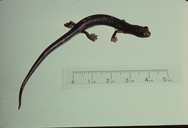|
Bolitoglossa epimela Wake & Brame, 1963
Subgenus: Eladinea | family: Plethodontidae subfamily: Hemidactyliinae genus: Bolitoglossa |
 © 2007 David Wake (1 of 2) |
|
|
|
Description In life, the species is mostly dark brown or black on the dorsal surfaces, with some tan, orange, pink, or white spots and blotches. The venter is dark and the coloration is nearly uniform except for some purplish to pinkish blotches (Savage 2002). Distribution and Habitat Country distribution from AmphibiaWeb's database: Costa Rica
Life History, Abundance, Activity, and Special Behaviors Trends and Threats Possible reasons for amphibian decline General habitat alteration and loss Comments A Spanish-language species account can be found at the website of Instituto Nacional de Biodiversidad (INBio).
References
Bolaños, F., Wake, D., and Savage, J. 2008. Bolitoglossa epimela. In: IUCN 2010. IUCN Red List of Threatened Species. Version 2010.1. www.iucnredlist.org. Downloaded on 09 April 2010. Savage, J. M. (2002). The Amphibians and Reptiles of Costa Rica:a herpetofauna between two continents, between two seas. University of Chicago Press, Chicago, Illinois, USA and London. Wake, D. B., and Brame, A. H. (1963). ''A new species of Costa Rican salamander, genus Bolitoglossa.'' Revista de Biología Tropical, 11, 63-73. Originally submitted by: Mae Huo (first posted 2009-11-02) Edited by: Kellie Whittaker (2019-03-06) Species Account Citation: AmphibiaWeb 2019 Bolitoglossa epimela <https://amphibiaweb.org/species/3973> University of California, Berkeley, CA, USA. Accessed Jul 26, 2024.
Feedback or comments about this page.
Citation: AmphibiaWeb. 2024. <https://amphibiaweb.org> University of California, Berkeley, CA, USA. Accessed 26 Jul 2024. AmphibiaWeb's policy on data use. |



 Raffaëlli Account
Raffaëlli Account Map of Life
Map of Life